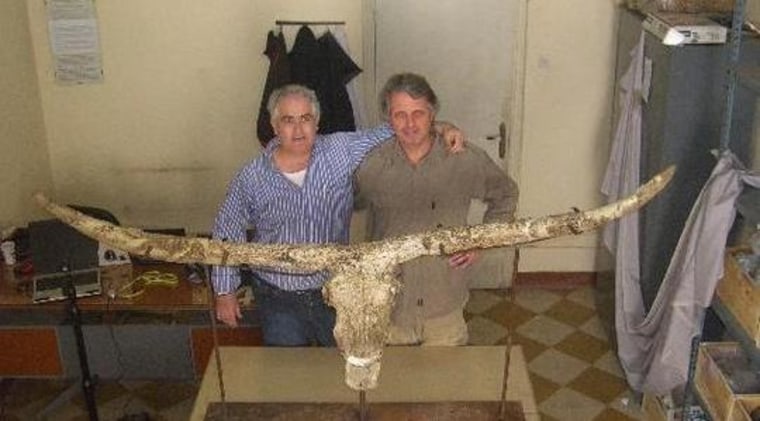The discovery of a new "missing link" species of bull dating to a million years ago in Eritrea pushes back the beef steak dinner to the very dawn of humans and cattle.
Although there is no evidence that early humans were actually herding early cattle 2.5 million years ago, the early humans and early cattle certainly shared the same landscape and beef was definitely on the menu all along, say researchers.
The telltale fossil is a skull with enormous horns that belongs to the cattle genus Bos. It has been reassembled from over a hundred shards found at a dig that also contains early human remains, said paleontologist Bienvenido Martinez-Navarro of the Universitat Rovira i Virgili in Tarragona, Spain. Martinez is the lead author of a paper reporting the discovery in the February issue of the journal Quaternary International.
"This means that the humans have been eating Bos since the beginnings of the genus Homo," said Martinez, referring to the genus to which humans belong.
The million-year-old skull of the new Bos species, dubbed Bos buiaensis, has features of both earlier and later forms of Bos, which make it essentially a missing link between more modern cow-like species found in Eurasia and the earlier African cattle ancestors found alongside hominids and dating back 2.5 million years.
"The most important point is that this Bos connects the African Bos with Eurasian bulls," and so confirms the long, uninterrupted coexistence of humans and cattle from the earliest times, he told Discovery News.
There are some researchers who might take issue with some of the details of the cattle family tree as Martinez and his colleagues have described it, but the overall conclusion seems sound, commented Sandra Olsen, curator of anthropology at the Carnegie Museum of Natural History in Pittsburgh.
"One way or the other, hominids are associated with these creatures," Olsen told Discovery News.
The distinctive horns of the new Bos also broach some other interesting matters, said Olsen. For one thing, this was an animal that had to live out in open areas, just like early humans. It's very hard to imagine any animal with such long horns surviving in a forest, she said.
Then there is also a tantalizing resemblance between the newfound Bos and depictions of bulls in ancient petroglyphs found in western Saudi Arabia — along the route once taken by humans out of Africa. The rock art shows exceptionally long-horned cattle being hunted by humans with bows, arrows and dogs, Olsen said. The petroglyphs are at least 5,000 years old, she said, but very hard to date exactly.
"(The new Bos species) look so much like the pictures in Saudi Arabia," said Olsen, "which people have thought were exaggerations."
The ancient pictures also include depictions of some of the other animals known to have left Africa by the same route: lions, cheetahs and hyena, she said.
The message from the new fossil echoes those being discovered about the prehistory of other domesticated animals, including horses, which Olsen has studied, in particular.
"We've seen over and over again," she said: "These are very long relationships."
